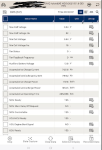Hi there,
I'm looking to get a 2021 Hyundai Ioniq Hybrid which has done 34k km overall. I've asked the dealer to provide a report of battery health check in the hybrid systme, which comes with a 240V battery and while they claim they are not able to get the health check up done, the voltage readings seem fine.
Attached are the screenshots which they have provided me.
Would anybody be able to tell me if the readings are fine?
This is a 1.6L GDI Hybrid electric vehicle, which as per wikipedia, comes with 1.38 kwh Lithium Ion bttery.
Hwowever, the fourth screenshot confirms an available charge power of 39.00 kW and a discharge power of 42.00 kW. Not sure what this means- can somebody clarify? Is the dealer correct or are they playing up by sending across something else for getting a quick deal.
Looking forward to hearing from you all.
Thanks in advance !
![Image]()
![Image]()
![Image]()
![Image]()
![Image]()
I'm looking to get a 2021 Hyundai Ioniq Hybrid which has done 34k km overall. I've asked the dealer to provide a report of battery health check in the hybrid systme, which comes with a 240V battery and while they claim they are not able to get the health check up done, the voltage readings seem fine.
Attached are the screenshots which they have provided me.
Would anybody be able to tell me if the readings are fine?
This is a 1.6L GDI Hybrid electric vehicle, which as per wikipedia, comes with 1.38 kwh Lithium Ion bttery.
Hwowever, the fourth screenshot confirms an available charge power of 39.00 kW and a discharge power of 42.00 kW. Not sure what this means- can somebody clarify? Is the dealer correct or are they playing up by sending across something else for getting a quick deal.
Looking forward to hearing from you all.
Thanks in advance !





